The science room/laboratory that you will be working in is equipped with equipment to ensure the safety of you and your classmates. It is important to know how and when to use each piece of equipment.
![]() Watch this video to learn more about the eye wash station, safety shower, fire extinguisher, and fire blanket.
Watch this video to learn more about the eye wash station, safety shower, fire extinguisher, and fire blanket.
Source: Lab Safety and Equipment Tour, drbodwin, YouTube
Let's review the equipment you saw in the video.
Eye wash stations and emergency showers are used to deal with chemical spills. If chemicals come in contact with the skin or eyes, the affected body parts should be rinsed thoroughly with large amounts of clean water, and your teacher should be notified. Any contaminated articles of clothing should be removed. Pictured below are two different types of eyewash stations and combination safety shower and eye wash.
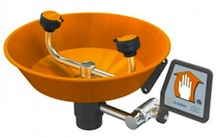
Gooseneck Faucet-mount Eyewash
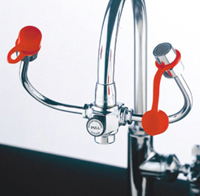
Eye wash station, Conney.com
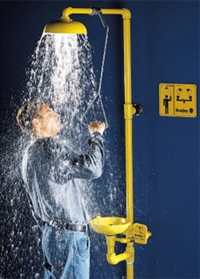
Safety shower, Conney.com
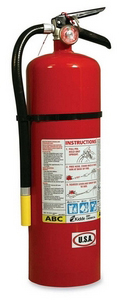
Fire Extinguisher, Etilize
Keeping the laboratory and storage areas neat and organized will prevent most fires. However, if a fire does occur, then it can be dealt with using a fire extinguisher and/or a fire blanket.
You should already be familiar with fire extinguishers. However, you may not be aware that there are several different types of fire extinguishers which are used to extinguish different kinds of fires. Using the wrong type of fire extinguisher may not only fail to extinguish the fire, it may make the situation worse. The table below summarizes the uses of the four types of fire extinguishers.
| Type of Fire Extinguisher | Type of Fire |
|---|---|
| Class A | ordinary combustible materials (paper, wood, cardboard, most plastics) |
| Class B | flammable or combustible liquids (gasoline, kerosene, grease, and oil) |
| Class C | electrical equipment (appliances, wiring, circuit breakers, outlets) |
| Class D | combustible materials often found in chemical laboratories (magnesium, titanium, potassium, sodium) |
![]() Watch the following video to learn how to use a fire extinguisher.
Watch the following video to learn how to use a fire extinguisher.
Source: Fire Extinguisher Tutorial, Sicem6, YouTube
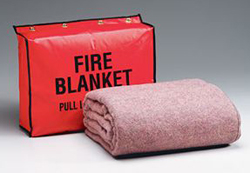
Fire Blanket, First Aid Product.com
The second type of fire safety equipment is the fire blanket like the one shown to the right. Fire blankets are used to smother fires on people. To use a fire blanket, first remove the blanket from its wall holder. Next, wrap the blanket around the flames on the person. The fire blanket will block the flow of air to the fire and cause the flames to die.